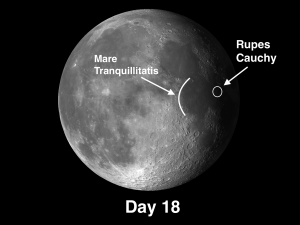I hope everybody caught the transit of Mercury across the face of the Sun on Monday morning!
The week of November 11-17 takes us from Day 14 (virtually the Full Moon) to Day 20. This week we will highlight the lunar fault Rupes Cauchy.
 Rupes Cauchy [NE/J13] One of the best-known faults on the Moon is Rupes Cauchy. It is fascinating to explore and is paralleled by a nearby rille, notice how an intervening small crater separates the rille and the fault.
Rupes Cauchy [NE/J13] One of the best-known faults on the Moon is Rupes Cauchy. It is fascinating to explore and is paralleled by a nearby rille, notice how an intervening small crater separates the rille and the fault.
The rille is located seven miles northeast of Cauchy crater. It is 130 miles long, 2½ miles wide, and twists itself into a tight double u-turn halfway between Cauchy crater and the rille’s northwest end. To the southwest of Cauchy is the 75-mile Rupes Cauchy, an impressive fault that actually changes into a rille at both ends. The changeover point occurs coincidentally at two small craters that mark where the fault line starts to curve slightly to the southwest. Look carefully and see if you can detect the difference between a rima (a long groove) and a rupes (a cliff). This will be more obvious at lunar sunrise as the Moon’s surface is higher on the northeast side of the fault and a conspicuous shadow will be cast toward the west. On Day 18 the setting Sun brightly illuminates the westward-facing slope of the fault. Because these two features are radial to the Serenitatis Basin they are probably associated with stresses that resulted from the Serenity impact nearly 3.9 billion years ago.
OF ADDITIONAL INTEREST:
For those who are new to this blog, the author has written a book on observing the Moon titled What’s Hot on the Moon Tonight? The Ultimate Guide to Lunar Observing. It is a nightly guide to the Moon’s most interesting features as they are revealed throughout the lunar month. It is highly recommended that you also obtain Sky & Telescope’s Field Map of the Moon, available on Amazon. Lunar features that are described in the book are keyed to the grid in the Field Map.
I was fortunate in that Charles Wood, author of The Modern Moon: A Personal View, a writer for Sky & Tel, and the country’s leading authority on lunar observing, was willing to write the foreword. The book is available on Amazon and from my website. (If you would like a signed copy, please order from my website.)
An eBook version of What’s Hot on the Moon Tonight is now available on iTunes and Amazon. An additional feature in the eBook version is the longitude of lunar objects has been added to the grid reference, e.g., Plato: [NW/D9; L=9°W], meaning open the Field Map to the NW quadrant, grid D9; Plato is at longitude 9°W. The longitude of a feature is enormously helpful when you are planning a night’s observation because any object which is within 15° or so of the terminator will stand out with astonishing detail!1
1 To find out what the longitude of the terminator will be for any night, download the free Virtual Moon Atlas onto your computer. Set the date to the night you wish to observe, then click on a crater on the terminator and read its longitude. Or use the Moon Map Pro app if you are lucky enough to have gotten it before it became unavailable on iTunes.
======================
It is highly recommended that you get a copy of Sky and Telescope’s Field Map of the Moon, the very finest Moon map available for use at the telescope. It is available for $10.95 at www.skyandtelescope.com and on Amazon. All features mentioned in this blog will be keyed to the grid on the Field Map and will look like this: Plato: [NW/D9]
Credits:
Courtesy of Gray Photography of Corpus Christi, Texas
Lunar photos: NASA / USGS / BMDO / LROC / ASU / DLR / LOLA / Moon Globe. Used by permission
- Rupes Cauchy: A Best Known Fault on the Moon - July 22, 2024
- Moon Crater Schickard – Crater Floor has Stripes - July 15, 2024
- Moon Craters Langrenus and Vandelinus - July 8, 2024